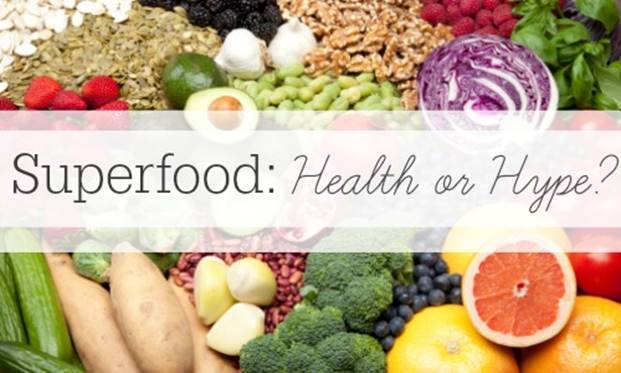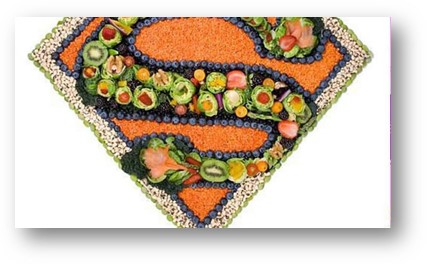
The “super food” label really bugs and makes us think in black and white, which is never a good idea. We simply can’t count on one food to heal us from whatever we ail from. In saying that, there are certain foods that contain more nutrients than others when we eat a normal amount (meaning you don’t have to eat a lot to get some mega nutrients) and have been shown in science to perform in a slightly more exceptional way. If you don’t feel like reading this whole article, just take this next sentence in and call it a day: all fruits and vegetables offer beneficial qualities to your bod (unless you have an intolerance or allergy).
Let’s be smarter than the food marketers. Why, you ask? Well, because they know that if they call their product a superfood, it’s sure to sell. Take quinoa, for example. When the ancient grain first became trendy, quinoa prices tripled in the span of five years. (Many Bolivians, who had relied on it as a food staple for centuries, were soon priced out of the market.) The moral here: it’s important to question anything too good to be true. You know you’ve heard this before! My friend found this evidence based article on this very subject, so I’m adding and editing as I see fit.

Some touted “super foods” (but are just healthy foods, not really “super”):
Gluten-Free Flours
If you thought eliminating gluten was your ticket to reducing inflammation, bloating, and losing weight, think again. Unless you have celiac disease or suffer from a true gluten intolerance (example: you are doubled over and running for the bathroom post meal), there are no proven physical benefits from going gluten-free. A 2012 paper in the Journal of the Academy of Nutrition and Dietetics found that there was not a single study connecting gluten-free diets to weight loss in nonceliac populations. It also pointed to studies that showed limiting gluten negatively affected gut flora populations, while diets high in gluten resulted in a lowering of triglycerides and blood pressure. If you can firmly trace your stomach woes to eating gluten (preferably through doing a two-week elimination diet), then gluten-free flours may be a superfood for you. But for the vast majority of Americans, they’re nothing but expensive, unhealthy substitutions.
Orange Juice
A 2014 study in the journal Nutrients found that men who were low in vitamin C caught fewer colds once they increased their vitamin C consumption, but the difference was deemed statistically marginal. Furthermore, another 2014 study published in Clinical Nutrition found that drinking orange juice didn’t lead to a strengthening of the immune system for healthy, well-nourished adults. So getting enough vitamin C is important, but slamming a gallon of orange juice won’t help—it contains too much sugar. Instead, try red peppers, broccoli, or kale, which all have more vitamin C per serving than orange juice. Plus, they have more fiber and other nutrients.
Coconut Oil
Coconut oil is the new snake oil. You’ll find it included in the ingredient list of nearly every “health” food, from packaged granola to yogurt. The big hype behind coconut oil is that it contains medium-chain triglycerides (MCT), which could help our bodies burn more fat. However, the research on this was flawed and bias. Better research is needed.
Chia Seeds
Many runners began incorporating these small seeds into their diet after Christopher McDougall’s 2009 bestseller, Born to Run, described them as nutritionally equivalent to a mix of “salmon, spinach, and human growth hormone.” But a few recent studies—like one in the Journal of Strength and Conditioning Research and one in the journal Nutrients—have found that the seeds offer runners no performance benefit. These seeds are good from a “general nutrition” standpoint. They provide macronutrients, including omega-3s, but there isn’t much super about chia seeds beyond that.
Kimchi
This pickled Korean dish has been recently hailed as a superfood due to its high probiotic content. However, how probiotics work is just too rudimentary to call kimchi or any food whose main selling point is probiotics a superfood. Still, kimchi is made up of all healthy things, like cabbage, garlic, ginger, and daikon. If you love it, go ahead and eat it, but it’s too soon to start stocking up.
Sweet Potatoes
Sweet potatoes have become the darling of endurance athletes looking for a natural fuel source, but the types of good carbohydrates that you can get from a sweet potato can be found in any number of other whole foods, like bananas, oatmeal, or dates. If you like sweet potatoes, and they are admittedly delicious, there’s no problem with eating them. Just know there’s nothing super about them.
Almonds
While almonds are great, Talbott takes issue with their designation as a superfood. Most nuts are created equal, he says. They’re healthy and full of good fats, and research shows that regular nut eaters tend to have healthier weights. Almonds are no more super than their other nut relatives.
Beets
While most of us have heard that beet juice can help with oxygen uptake, the ergogenic benefits of this plant have been largely overblown. Research on the topic is all over the place: in a recent study published in the Journal of Applied Physiology, beet juice didn’t improve the performance of cyclists. But in a 2014 paper, beet juice did improve cycling performance in athletes at altitude. And in 2015, another study found no benefits from beet juice for runners at altitude. So the jury’s still out on the exact performance benefits of this vegetable, but the bottom line is that many of the antioxidants in beets are available in other fruits and veggies like lettuce, spinach, and strawberries.
Acai
It’s basically the Brazilian blueberry. Like blueberries, acai berries are full of great antioxidants (and absolutely delicious). But they are expensive and hard to find. Because of this, research on acai’s benefits is still sparse. You’re better off just buying frozen blueberries for your smoothie.
Eggs
Eggs are great! They’re full of protein and vitamins and minerals, plus they’re cheap; but they’re not actively working to lower your blood pressure, fight cancer, or make you smarter. Eat pasture raised if you can.
Tart Cherry Juice
There is good research showing that tart cherry juice can relieve post-exercise muscle soreness and may even help prevent post-race colds in endurance athletes. But it’s relatively low on this list of superfoods because it’s such a specialized use. Sure, some athletes may see benefits, but most people would be better off using turmeric for relieving daily aches and pains and post-exercise soreness. Plus, tart cherry juice is expensive, and if you get the real, no-sugar-added variety, it’s more sour than sweet.
Some legit “super foods”:

Broccoli
If you’re surprised to see broccoli and not kale on our list, don’t be. Broccoli is cheap, full of fiber and vitamins, and contains sulforaphane, a compound that actually helps cells fight cancer. Broccoli activates pathways inside the cell so the cell starts creating its own antioxidants. Recent research has shown that some organs respond better than others to broccoli’s anticancer properties, but the fact that any of them respond at all is pretty remarkable.
Coffee
At the right dose, coffee does have real benefits. Caffeine is the most-researched performance product on the planet, and it has the same beneficial flavonoid content as tea. Plus, there’s research showing regular coffee drinkers may have a lower risk for dementia, diabetes, and maybe even Parkinson’s.
Apples
That “apple a day” adage is not total bull. The flavonol quercetin makes these boring old fruits worth adding back into your lunchbox: quercetin has been shown to lower blood pressure, open blood vessels, and improve endurance athletic performance.
Green Tea
This ancient beverage has been adopted by the diet industry, which makes it seem gimmicky. While green tea diet pills are certainly worth being wary of, plain green tea is not. There is research showing that it can boost your basic metabolic rate by 3 to 4 percent, and it’s profoundly anticancer thanks to compounds called catechins. In fact, research in the journal Cancer Prevention found that daily green tea consumption could delay the onset of cancer by more than seven years for women and three years for men. A large-scale population study published earlier this year in Cancer Science followed nearly 90,000 Japanese citizens for more than a decade and found that those who drank large amounts of green tea had lower risks for biliary tract cancer, gallbladder cancer, and bile duct cancer.
Black Beans
If you compare the diets of every culture with a beyond-average life expectancy, including the original Blue Zones (longevity pockets of the world) of Okinawa, Japan; Sardinia, Italy; Nicoya, Costa Rica; Icaria, Greece; and Loma Linda, California, the one shared food tradition is hearty doses of legumes. They’re high in fiber, iron, and B vitamins, and research has shown that diets rich in legumes (plus lean meats and vegetables) can lower your risk of developing cardiovascular disease and your total risk of morbidity from all causes. While all legumes are worth including in your diet, black beans are packed with polyphenols, giving them an extra nutrient boost.
Dark Chocolate
To get the reported benefits from chocolate, you really need to eat the super-dark stuff; 70 percent cocoa or higher. Studies have shown that just a few ounces can deliver a heart-healthy dose of flavonols that lower LDL cholesterol, stabilize blood sugar levels, and improve blood flow. Plus, as we all anecdotally know, there’s research showing that eating chocolate can boost your mood.
Red Wine
Go ahead and rejoice: there is evidence-based research showing that wine may have anti-inflammatory and blood pressure–lowering benefits, thanks to the polyphenol micronutrient called resveratrol, which research has linked to a host of cardiovascular benefits (although many of these studies were performed on rodents, not humans). A 2009 review in the Journal of Nutrition found a significant body of research pointing to a lowered risk of all-cause and cardiovascular mortality for populations that consume resveratrol-rich foods such as red wine. If you aren’t an alcohol connoisseur, a serving of red grapes may be just as good. Although be wary of resveratrol supplements: one study was actually suspended because participants reported kidney complications. Not that you’d ever want to skip that glass of red wine for a pill, of course.
Salmon
The omega-3 fatty acids in salmon contain docosahexaenoic acid (DHA) and eicosapentaenoic acid (EPA), which help boost brain and heart health, respectively. Omega-3s help with blood vessel compliance and have a nice blood-thinning effect which can reduce the risk of heart attacks and strokes. A 2012 paper published in Epidemiologic Review found that women who increased their fish intake, including salmon, late in life had significantly fewer incidences of coronary heart disease. Additionally, salmon’s DHA, which you can get only through diet since your body does not naturally produce it, acts as a membrane to neurons in the brain, protecting them from damage or inflammation. A 2015 meta-review in Neuroscience and Biobehavioral Review found that an increase in fish consumption could reduce the risk of Alzheimer’s by more than 30 percent.
Turmeric
This powder, which comes from the rhizomes of the Curcuma longa plant, has been used in ancient medicine and Southeast Asian cuisine for centuries. Turmeric’s clearest benefit is that it is profoundly anti-inflammatory, thanks to curcumin, a natural polyphenol that also gives the powder its bright yellow hue. The body of research on turmeric is fairly deep, with several large-scale studies, and turmeric may have more benefits than researchers yet realize. Results from one small study in the UK showed a potential for turmeric to change gene expression in a way that might help fight cancer. It’s best to eat turmeric at a suggested dose of one-fourth teaspoon three times a day along with some fiber and fat for maximum absorption. (He sprinkles turmeric on sandwiches, adds it to salad dressing, and even puts it in his coffee.) A word of caution: turmeric is very pungent.
Blueberries
They lower your risk for heart disease, reduce joint and muscle pains, and curtail oxidative stress (the naturally occurring stress produced by cell respiration). Blueberry’s power comes from the compound oligomeric proanthocyanidins, and you don’t need a ton of it to get results: a half-cup per day of fresh or frozen blueberries results in a significant longevity benefit. Plus, there’s plenty of research showing that blueberries can reduce post-exercise stress and inflammation among athletes. As for the general population, in 2013, researchers revealed that—at least for women—getting three servings of berries per week cut heart attack risks by one-third.
So there you have it… evidence based “super food.” In saying that, all of the food listed is healthy and food I would recommend any ol’ day. I just wanted to point out what foods have been shown to go above and beyond. Really it’s what you do on a consistent basis; from day to day. So even if you ate only these “super foods,” I would still suggest you vary your diet and incorporate some of these other foods listed.
Be well my friends. Toodles!
Miriam Turner
Studio SWEAT Dietitian
Resource: https://www.outsideonline.com/2128816/definitive-superfood-ranking









Comments - 0